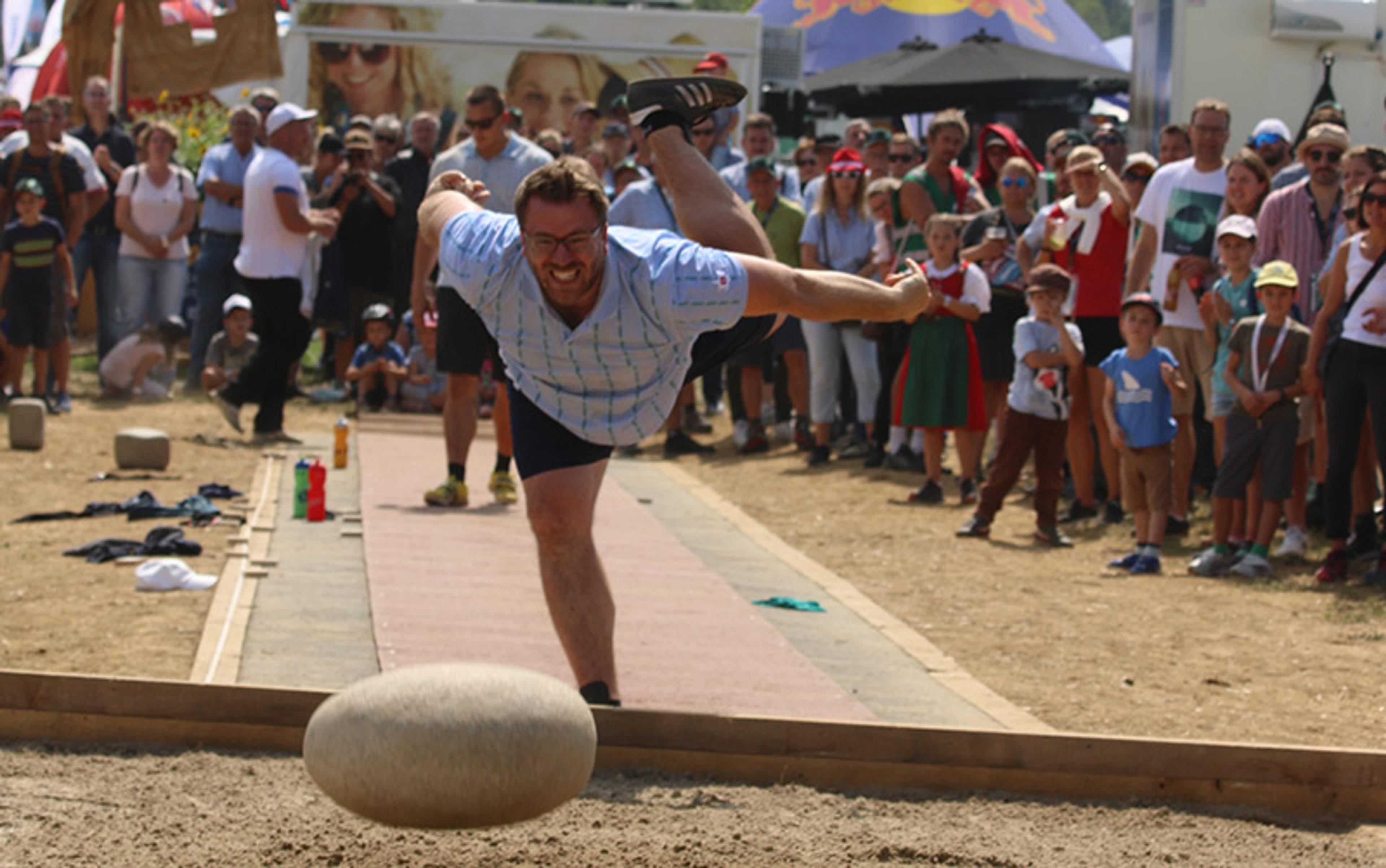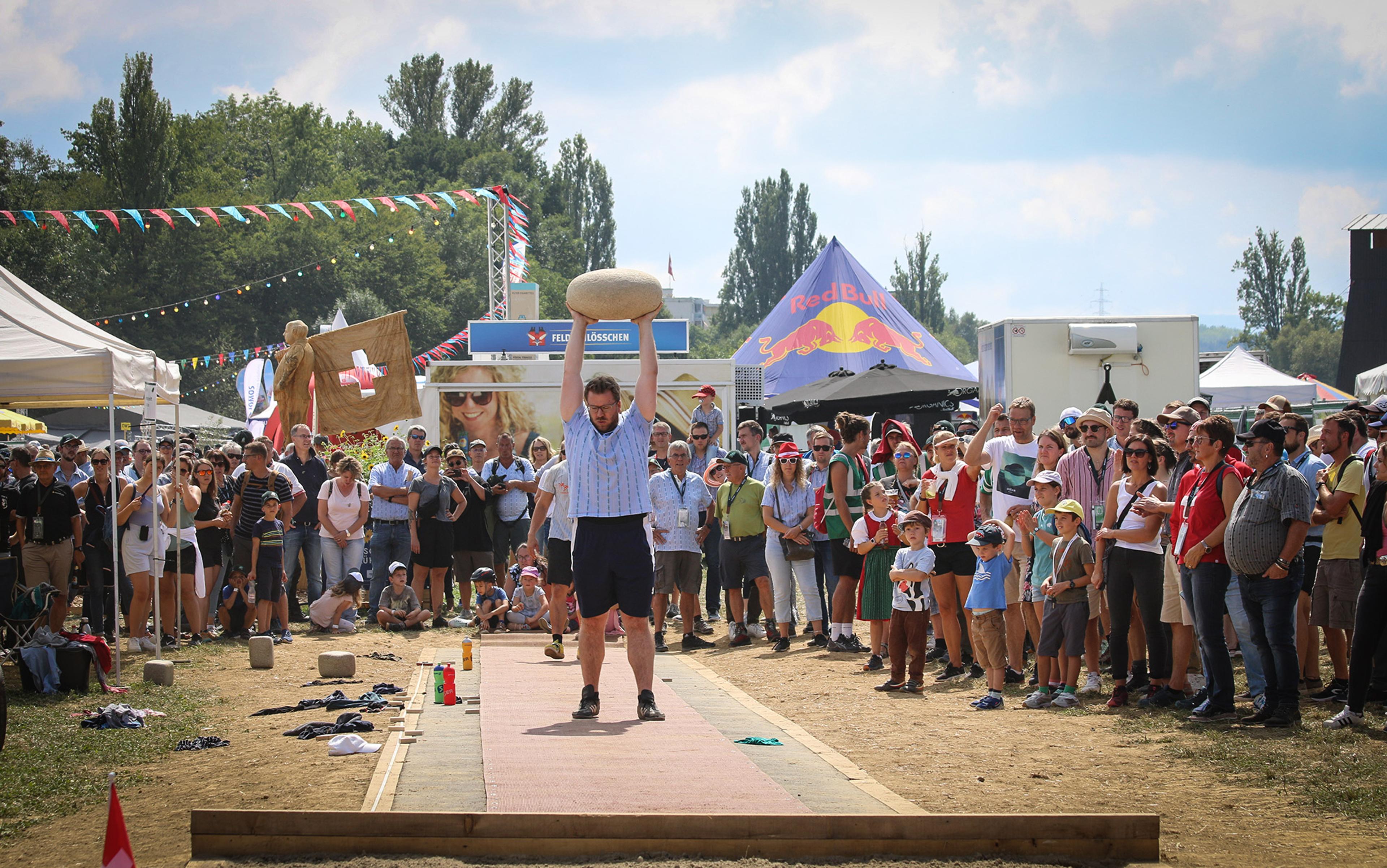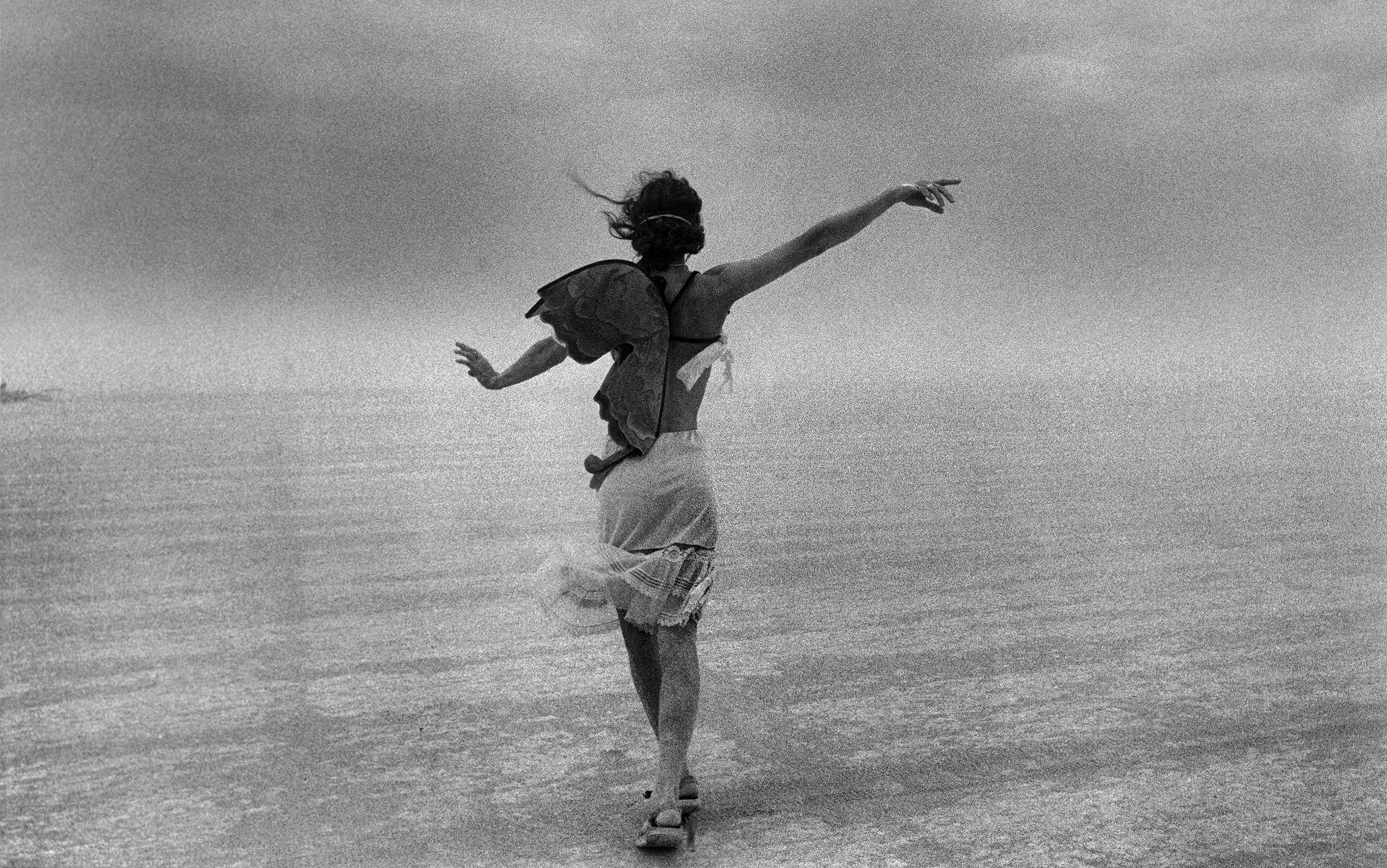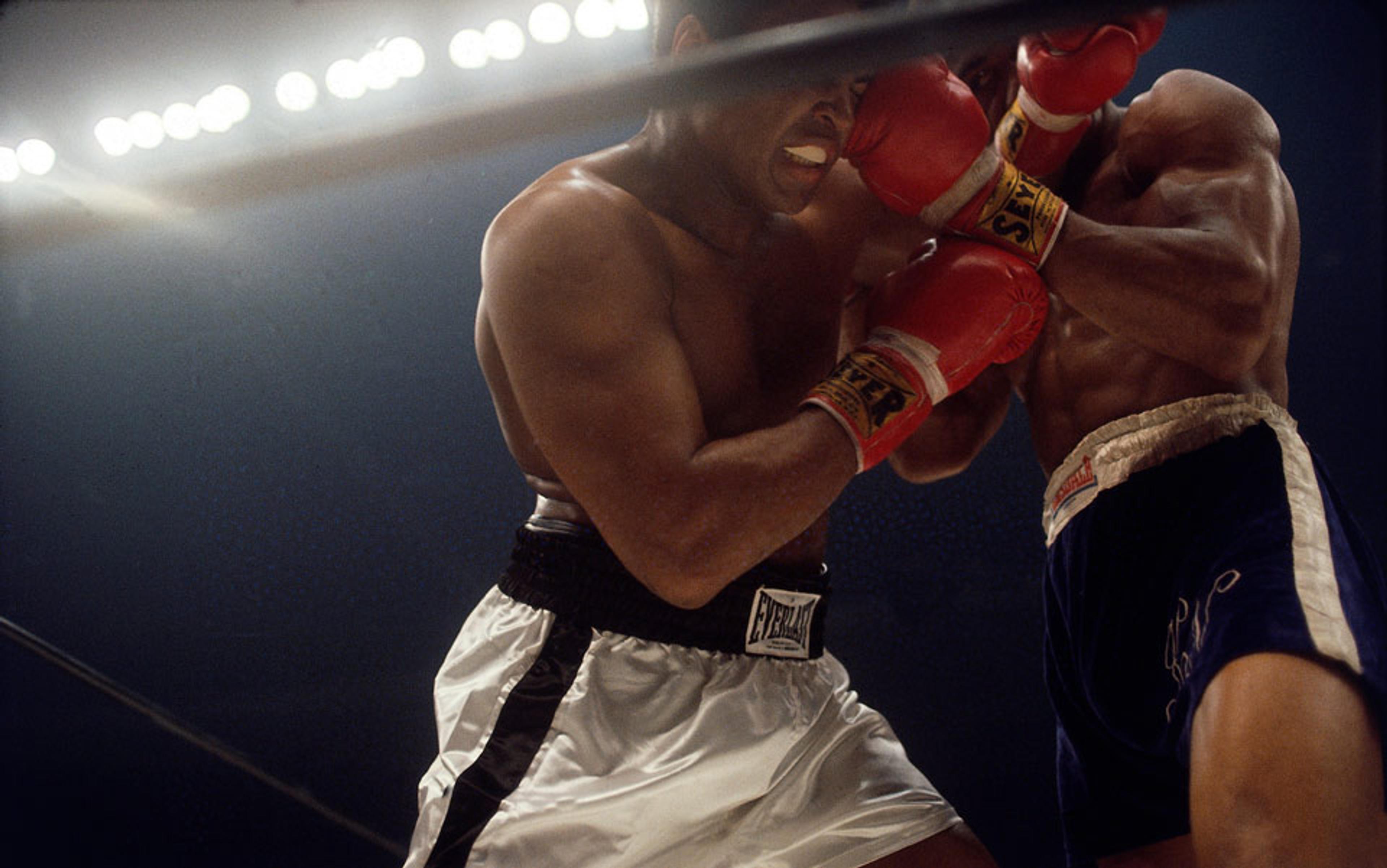Between my feet sits a 184 lbs boulder. The rock has a slightly oblong, albeit uneven shape. It’s made out of granite from the Bernese Alps, and has the years 1805 and 1905 engraved into it – historic dates of the Unspunnenfest, a celebration of Swiss cultural traditions. A few hundred spectators are here to watch the early heats for stone put at the 2023 edition of the Unspunnen games. Only the best three athletes will advance to the televised finals in the games’ main stadium, which seats around 16,000 people. To make it there, I will need to throw near the 12 ft mark. I hold my breath and get into position. I lift the boulder above my head, find a comfortable position, and set my feet ready to start my run-up: I need to build up enough speed on the roughly 40 feet between me and the edge of the sandpit.

The author hurls the Unspunnen stone, hoping to reach the competition finals in Interlaken, Switzerland in 2023
The scale of the finals – the live television cameras, commentators, pundits and doping tests – clash with the romanticised image of an Alpine life of pastoral idyll that the competition self-consciously preserves. Stone putters compete with historical boulders, and the games emphasises tradition and the pastoral imagery that goes along with it: athletes wear the traditional, light-blue shirts of Alpine dairymen, and compete for bells or ornately carved wooden furniture. They’re led into the arena by ‘ladies of honour’, also in traditional costume. The sport of stone put, then, seems to be first and foremost a tradition.
The first Unspunnenfest was inaugurated in 1805 near Unspunnen Castle, as an explicit response to the instability that gripped Switzerland as part of the French revolutionary wars. Following the French occupation of Switzerland, the Bernese patriciate families (to whom all founding members belonged) were engaged in a prolonged renegotiation of their hegemony vis-à-vis the rural communities. Napoleon’s army had stayed in Switzerland until 1802, and under his reign the rural regions enjoyed unprecedented autonomy. When it left, these areas again fell under the government of the city of Bern: a state of affairs that had within it the potential for civil war and rebellion. The urban elites wanted to preserve the power structures of old, before the turmoil and ideas of the French Revolution upset the status quo. The founding fathers of the games tried to do this by emphasising the preservation of traditions. They made no outward mention of their true intention of bringing the rural communities back under their sway. Instead, they publicly invoked the reconciliatory power of tradition. In a newspaper announcement, the co-founder Franz Sigmund Wagner describes the ‘sole purpose’ of the games as that of ‘reviving and preserving the simple old traditions and joys of our forefathers [so as] to let ancient, mutual good will grow and bloom again.’
The patriciate embraced Alpine traditions because it was a way to sustain their conservative aristocracy. The Unspunnenfest marks one of the first occasions in Swiss history where genuinely old traditions were presented in a new context, with political goals, and under an explicitly conservative guise. The festival of 1805 thus betrays the hallmarks of what the British historian Eric Hobsbawm in 1983 called an ‘invented tradition’. Perhaps for this reason, the ostensible goal of the festival’s founders – reconciliation – failed. The secret files of the Bern state council of the time reveal that the political opponents of the patricians saw through their deception. They contain a note from Friedrich Ludwig Thormann, another of the co-founders, according to whom a man from the town in which the Unspunnenfest was to be held had stockpiled gunpowder and ammunition. Johan Caspar Beugger, one of the champions of the inaugural games, was later arrested as a revolutionary in the 1814 uprisings.
This is where the alliance between Alpine tradition, nostalgia and conservatism was first made: anything that didn’t fit the image of the Alpine traditions that the Unspunnenfest organisers had conjured up needed to be rejected. On 30 March 1804 (one year before the festival), Thormann accordingly vowed to ‘suppress everything’ that runs counter to and challenges the structures of the old. Things needed to be a certain way because they had always been that way. The ideas of the French Revolution brought dangerous innovations that – as Wagner writes in his personal notes – would spell ‘complete ruin [for] the old, venerable traditions of our Alpine people’. On this conservative view, a tradition is what needs to be preserved and handed down, unmixed with any alien intrusions. Tradition, therefore, stands in contrast to progress.
But does conservatism really have a monopoly on tradition? Is tradition inevitably the property of nostalgia and the natural ally of those looking backwards, driven to preserve and keep things the way they were in the past? Can conservatism be uncoupled from tradition?
The conservative concept of tradition finds its fullest and most influential philosophical expression in the work of the Anglo-Irish statesman and philosopher Edmund Burke. Like the Bernese patriciate, Burke reacted with disapproval to the French Revolution, as he explained in his Reflections on the Revolution in France (1790), a defining work of modern conservatism. It is here that he articulates the alliance of tradition with conservatism that remains popular today.
Burke’s best argument in favour of tradition is based on its social utility: tradition provides a strong and perhaps even necessary basis for social solidarity. The dissolution of all tradition, he holds, will mean that nothing but force and the fear of punishment will hold society together. Burke accordingly equated the revolution in France with a self-consciously arbitrary and tyrannical rejection of tradition. As he wrote in a letter in 1791, what had taken place was ‘a revolt of innovation, and thereby the very elements of Society have been confounded and dissipated.’ Tradition shapes political structures and the social order, so adhering to it ensures the stability and ‘unchangeable constancy’ of the political system. A few years later, when the Reign of Terror descended upon France and thousands met their end on the guillotine, many accordingly saw Burke’s warnings justified. It seemed that innovation and revolution, unmoored by the certainties of tradition, led to ruin and chaos.
The kind of changes and developments that Burke envisages are not progressive or innovative
Burke defined ‘tradition’ as that which is an ‘inheritance from our forefathers’. This inheritance, which comprises civil institutions, ancestors, monuments and other cultural artefacts, instils in us a sense of dignity and nobility. We revere our traditional inheritance not because it has some intrinsic value, but because it is old: the mere fact of its age instils in us a natural sense of reverence. This reverence also explains why we have to preserve it. Burke makes clear that preserving tradition is a matter of conserving it unmixed with any intrusions – as he puts it, we must take care to not ‘inoculate any scion alien to the nature of the original plant’. To graft a tree onto the stem of a different plant would be against nature and therefore destructive.
While Burke is resistant to the idea of revolution and radical change, he does allow and embrace certain kinds of change: those that are based on tradition, and which are thus essentially modifications of traditions. Specifically, any reforms should be modelled on precedent, authority and example from our forefathers. Tradition allows us to orient ourselves with regard to the authorities of the past, and it is by the use and reliance of analogies on traditional ideas that we find solutions for current problems. In any given situation, one should first consult the forefathers and ask how they solved the problem. The kind of changes and developments, then, that Burke envisages are not progressive or innovative. They are fundamentally conservative.
So, on the conservative way of thinking, tradition self-consciously stands in contrast to progress. In response to our question – whether conservatism has a monopoly on tradition – this dichotomy between tradition and progress is evidence that conservatism has successfully claimed tradition as its own. However, it is not evidence that their alliance is baked into the concept of tradition itself. We can see the latter point by going even further back in time to before this alliance became fortified, to Aristotle and his Sophistical Refutations.
The Sophistical Refutations is the last book in the collection of Aristotle’s writings on logical analysis and dialectic. These are known as the ‘Organon’, a label that his students applied to this part of his corpus because these writings concern the instruments (organa) for knowledge and scientific enquiry. The concluding lines of the Sophistical Refutations provide Aristotle with an opportunity to reflect on the intellectual debts he owes to those who worked on these topics before him. In these lines, he articulates two concepts of tradition – one conservative and one progressive. Aristotle’s different concepts of tradition emphasise different aspects of what we today simply call ‘tradition’. One picks out the contents that are to be passed on (and which must be preserved). The other emphasises the action of passing something on for development or completion. Aristotle uses two different words for them: paradosis for the former, conservative kind, and epidosis for the latter, progressive concept. On this view, tradition and progress are not opposing forces. Aristotle is clear that a worthwhile contribution in any field will be part of a progressive tradition and not a conservative one.
The first part of his case involves reflection on what a conservative tradition can and cannot accomplish. With its emphasis on the content that is passed on, the conservative concept of tradition envisages a model in which those at the receiving end of a tradition learn by rote what is passed down to them. Aristotle offers two examples of what conservative tradition looks like in practice. First, there is Gorgias who ‘used to hand out rhetorical speeches to be learned by heart’. Second, there are the teachers of eristic (ie, of arguments designed to dispute any and all arguments an interlocutor might produce, regardless of their truth), who ‘handed out speeches in the form of question and answer’ that, like Gorgias’ rhetorical arguments, are to be memorised by the recipients. The focus in both examples of the conservative tradition is on the contents that someone produces: they pass on the contents of their work to be preserved exactly as they were.
The expectation of both Gorgias and of the teachers of eristic speech is that any problem or question could be adequately dealt with by consulting the memorised content. The consequence of this is that this concept of tradition warrants things staying a certain way: a certain kind of question will always receive the exact same answer. Tradition is a stock of wisdom that we inherit from our forefathers, consult in any situation, and on the precedent, authority and example of which we model our own solutions to problems. This is a view of tradition as inherently backwards looking: it is preoccupied with preserving things unchanged and unadulterated. Burke would wholeheartedly agree.
A conservative tradition equips those who rely on what is handed down with false views about a subject
But Aristotle recognises a danger of the conservative view. He compares this kind of tradition to passing down a collection of all the different kinds of shoes – rather than the art of shoemaking:
For they used to suppose that they trained people by imparting to them not the art but its products, as though anyone professing that he would impart a form of knowledge to obviate any pain in the feet were then not to teach a man the art of shoe-making … but were to present him with several kinds of shoes of all sorts.
This points to an important shortcoming of conservative tradition. The preoccupation with preserving specific contents deprives those at the receiving end of the ability to actually master the contents being passed down and make progress on them.
Aristotle observes that, while a tradition that preserves and passes on specific contents to later generations has the advantage of being quick and relatively easy to implement, it also involves a pernicious kind of ignorance (atechnia). In particular, he suggests that, while those at the receiving end of a conservative tradition may be able to meet some of their needs by relying on the materials passed on to them, the very possession of these contents impedes their progress to actual competence and thus also their ability to make progress. It isn’t just that a conservative tradition involves a lack of insight, but that it equips those who rely on what is handed down or delivered to them with false views and ideas about a subject. Think of those who learned by heart the rhetorical arguments of Gorgias or the arguments in question-and-answer form from the teachers of eristic: even if they become very skilled at deploying these arguments, the very possession of that skill will hamper their ability to produce arguments of their own.
By contrast, the progressive concept of tradition – which Aristotle himself endorses – emphasises not contents but the action of passing something on for development. This progressive concept of tradition fits into Aristotle’s broader optimism about human knowledge, which he believes to have a broadly teleological structure. In this concept of tradition, the contents that are passed down to later generations are small in comparison with what will be developed from them later on, and the significance and importance of these traditional contents lies not in what they currently are but in the substantive later developments they facilitate:
[I]n the case of all discoveries the results of previous labours that have been handed down from others have been advanced bit by bit by those who have taken them on … As the saying is ‘the first start is the main part’; … for in proportion as it is most potent in its influence, so it is smallest in magnitude; … but when this is once discovered, it is easier to add and develop what remains.
Tradition is not the conservation of these small starting points in unchanged and unadulterated form but their development through passing them down to successive generations. The emphasis, in other words, in progressive tradition is not on the contents inherited and passed on, but on their development. Their power lies in their potential for progress: tradition makes investments in the future.
However, given this focus on development, why think about this as ‘tradition’ at all? Aristotle thinks it is often easier to develop something further when a tradition (in this sense) exists than if we had to begin with a blank slate. Rhetoric ‘has attained considerable dimensions’ only because of this progressive kind of tradition (no thanks to Gorgias, Aristotle says). The ‘celebrities of today’ are in their position of prominence because, Aristotle says, they are ‘heirs (so to speak) of a long succession’ – ie, of a progressive tradition. By contrast, Aristotle considers himself to be making the very first contributions to dialectic. His achievement, as he sees it, is that he began with a blank slate and for the first time put something in place that can now be developed. Aristotle realises that it will strike some as implausible to claim that nothing at all existed on this topic before his own work: the eristics, one could argue, had already long been practising dialectic by the time the Sophistical Refutations were written. Aristotle rebuffs this objection by explaining that this earlier work is part of a tradition of the conservative type, that is, the tradition that emphasises the preservation of specific contents that are handed down and not the passing on of something for development and completion.
Aristotle makes available to us the idea that the alliance of tradition and conservatism is not part of the concept of tradition itself. The progressive view of tradition he outlines is not just compatible with progress – the issue is not about how to reconcile the opposing forces of two sides of a dichotomy – but tradition is itself a way of making progress. Moreover, what Aristotle has to say about the conservative concept of tradition in the context of the eristics, Gorgias and the passing on of footwear suggests that the alliance between tradition and conservatism not only fails to be inevitable but is in fact an uneasy pairing to begin with.
Which brings us back to the Alpine festival. Stone put is a tradition that consists in a sport. Historically, this claim has been parsed through the lens of a conservative understanding of tradition and taken to express two irreconcilable ideas: as a conservative tradition, stone put is to be preserved unchanged; but, as a sport, it is about improving (both on oneself but also upon others) and so beholden to what athletic progress demands, whether that is better equipment, training methods or venues. The dichotomy between conservative tradition and sport is so sharp that a schism emerged in the 1980s: conservative traditionalists argued that athletes treating the Alpine games as a sport – which meant that they systematically trained and prepared for the competitions – violated the spirit of the festival, and led to them having an unfair advantage.
However, following Aristotle, we can dispense with this old dichotomy, and think of stone put itself as a progressive tradition. Stone put should be thought of as a tradition in the sense that it passes its contents forward for improvement and ultimately perfection. What is passed forward can in principle include both what is central to the sport – its rules, records, equipment, techniques, as well as the implements with which the athletes compete – and what is incidental to it (such as the nature of the prizes, the specifications of the dress code, etc). The relevant criterion for whether something comes within the reach of a progressive tradition is only whether the concept of tradition emphasises the act of passing it forward for development or the preservation of specific content in unadulterated form.
Of course, one can alternatively join the founding fathers of the festival and think of stone put in a nostalgic way, with the conservative concept of tradition that emphasises the preservation of particular contents. This lends itself to invented traditions with its idealisation, romanticisation and fictionalisation of the past (which is where, historically speaking, the blue shirts of dairymen for athletes, bell prizes, historic costumes, ‘ladies of honour’ etc have their origin). The reason for this – as we saw with the patrician fathers of the original festival – is that what matters to those who define conservative traditions is not whether these traditions are invented or genuine (or whether successive generations can in fact successfully preserve what is ostensibly old and unadulterated) but whether these traditions accomplish for them what they intend them to accomplish in the present.
The stone had lost 4.5 lbs and, due to the position of the new engravings, was no longer the same to handle
By contrast, in a progressive tradition of stone put, the bells, historic costumes etc will not be part of the tradition of stone put at all. The athletic activity itself constitutes the tradition: throwers pass on their techniques, records and insights about training to later generations. The very nature of sport and athletic competition requires that those things are passed forward for successive perfection (rather than preserved unchanged). Moreover, due to one of its most unique features – the use of the same stone in competition – the concept of tradition that emphasises the act of passing things forward is not merely extrinsic to stone put but part of the athletic activity itself: since the festival aims to retain the same exact stone for competition, the history of the sport is saliently involved in the athletic act itself.
From the moment the stone putter uses the dates engraved in it to position the rock for the initial overhead clean, they know that this stone has been used in competition by many athletes before them and will be used by many more after them. Projecting the same stone – a reified metaphor for the enduring – into the sandpit as part of an athletic competition, they know that they are developing something and also laying the starting points for further development by later generations of athletes. We need the forward-looking concept of tradition to make sense of the sport.
Even here, however, stone put is not a tradition in the sense that it seeks to preserve a specific item or content. This is illustrated by stone put’s reaction to one of the more bizarre aspects of its history. In 1984, the Unspunnen stone was stolen by a group of four Jura separatists (who seek complete independence of the Jura region from the canton of Bern). Those who took the stone – as well as those who complained most vocally about its disappearance – tended to argue their case in terms of the stone’s role as a relic of what I have been calling the conservative concept of tradition: a tradition, so it seemed to them, that had been disrupted.
When the stone re-appeared in 2001, the separatists had made a series of further engravings in it. As a result, the stone had lost around 4.5 lbs in weight and, due to the position of the new engravings, was no longer the same to handle (opinions differ on whether it has become harder or easier to hold). In short, the stone was no longer usable for competition. Interestingly, however, this left the discipline of stone put largely unimpressed. The keepers of the stone in Interlaken immediately commissioned a replica, and when, once more, that replica disappeared in 2005, a long-time great of the sport went as far as saying that he was glad the stone was gone again, hopefully for good this time. The replica, he added, was much nicer as a sporting implement anyway. What happened here can be explained in terms of the two different concepts of tradition gripping past each other: the disappearance concerns the conservative tradition, but the sport of stone put ultimately embodies a progressive one.
Conservatism, then, does not have a monopoly on the kind of tradition my fellow stone putters and I are engaging in on this day at the 2023 Unspunnen games. Uncoupling tradition from conservatism in the way that the progressive concept of tradition proposes to do promises a remedy against an anxiety that defines our time: how can we make progress without thereby becoming disconnected from where we began and without thereby growing fearful of the process itself? Aristotle’s concept of tradition makes available a model for how traditions survive the progress they are instrumental in facilitating, and how their content changes in the process. A progressive tradition gives us the tools to balance our own achievements and the achievements of our time on the one hand, and the value and authority of tradition on the other. In doing so, it enables us to constructively criticise the processes by means of which political and social progress is made, without damaging trust in them.
As I reach the edge of the sandpit – boulder balanced overhead – I plant my left foot, jump and push up and against the 184 lbs to let it fly. I land on my right foot with my arms outstretched to keep my balance (overstepping or stepping onto the beam renders the attempt invalid). The rock lands with a thud, and the officials approach with a stick and measuring tape: 11.98 ft puts me fourth overall. This is, narrowly, not enough to take me to the finals tomorrow; but it is certainly a starting point.






